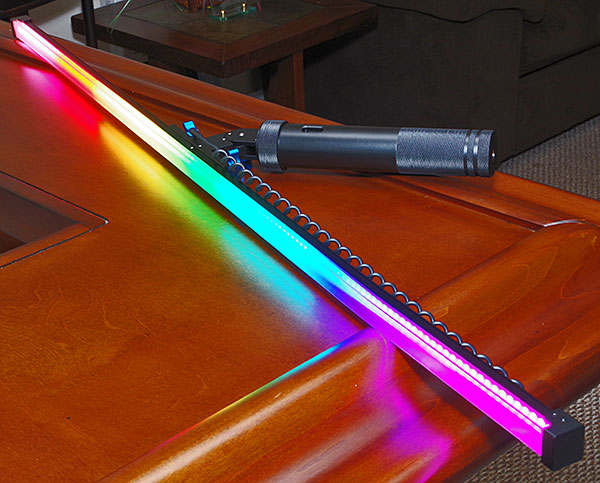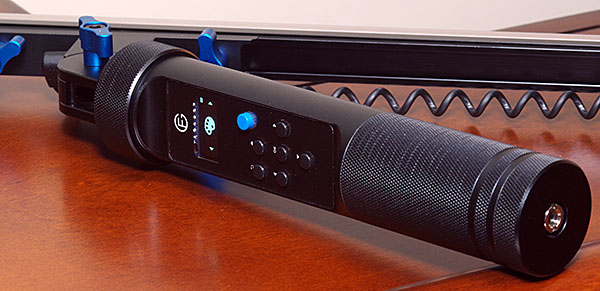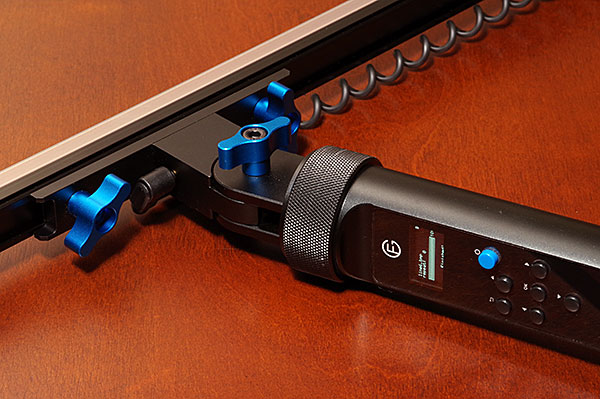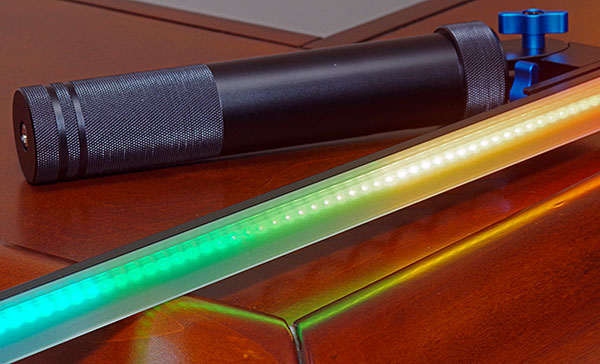Fotorgear Magilight launches on Indiegogo as a more affordable, portable, ergonomic Pixelstick alternative
posted Wednesday, January 17, 2018 at 4:38 PM EST

A few years ago, light painting as an artform was reinvented by the arrival of one seriously cool gadget. Bitbanger Labs' Pixelstick debuted to great acclaim, quickly whistled past its funding goals on Kickstarter, and wowed reviewers and customers alike with its artistic potential.
That's not to say it was perfect, by any means, though. Its collapsible design was a bit fiddly to assemble, its ergonomics were perhaps a little questionable, and its pricetag was on the steep side for what was, essentially, a fancy, full-color flashlight. Now it has a rival which aims to address some of these shortcomings, in the form of the Fotorgear Magilight which just launched on Indiegogo.
Spiral light trails painted into the image with a pre-production Fotorgear Magilight. Image captured with a Ricoh Theta V. - Spherical Image - RICOH THETA
I've been hands-on with the Magilight for the last few days, and while I've yet to have a chance to really unlock its potential -- it's been bitterly cold here in East Tennessee the last few nights, and this isn't a town which deals with snow well, so I've been something of a shut-in -- I'm definitely impressed with what I've seen thus far.
Perhaps the most important difference between the two devices is in their size, and it's in this respect where the Magilight is perhaps most limited compared to its already-entrenched rival.

The Pixelstick has a two-piece design which allows the wand to span a whopping 73 inches in length, giving you the ability to light-paint a little over six feet in one go. By way of contrast, the Magilight's wand is much shorter, coming in at just a smidgen under 40 inches.
That difference means you'll be able to cover a smaller proportion of your image area in any one sweep of the wand. But with 144 LEDs along its length, the Magilight packs in about 3.6 LEDs per inch, versus 2.7 per inch for the Pixelstick, meaning that it has higher resolution. This also means that it could be used closer to the camera while retaining similar resolution, if that works for a particular scene, subject and composition, anyway.
Rainbow light trails painted into the image with a pre-production Fotorgear Magilight. Image captured with a Ricoh Theta V. - Spherical Image - RICOH THETA
Together, the 144 LEDs are said to offer a total of 800 ANSI lumens of brightness at their maximum output, and can yield a total of 15 million colors. You can dial the brightness from full power anywhere down to just 4% power, and you can either choose from preselected wand colors, dial them in directly, or import bitmap images for display row by row on the wand. The Magilight also allows you to configure a variety of blink patterns (one of which you can see accidentally left enabled in the Imaging Resource logo light painting!), as well as support for animations, color temperature control and more.
As you'd expect, you can also adjust the position and angle of the grip by loosening the blue anodized knobs, and you can also freely spin the Magilight by gripping the knurled ring atop the grip in one hand, then turning the base of the grip, which is also well-knurled for good purchase. At the base of the battery cover, which unscrews from the bottom of the grip, there's even a tripod mount which will allow the Magilight to be attached to a vehicle, hung from a drone, etc.

Where the Pixelstick places its battery pack and control unit on the wand itself, increasing the mass of the portion you're trying to wave around, the Magilight more sensibly puts them inside the handgrip, which makes lighter work of moving the wand and changing its speed and direction. It also means you can keep your thumb on the controls at all times, ready for a quick change of the image being projected, or to start another sequence at the right moment.
And initially at least, the Magilight is also much more affordable than its rival. Where the Pixelstick is currently priced at US$350, the Magilight is currently selling for just US$180 or thereabouts, barely half the price of its rival. Admittedly, that's not quite the full story on pricing, as only a limited number of Magilights -- around 600 in total -- can currently be purchased at this price, and regular retail pricing is said to be $400.
The Imaging Resource logo light-painted across my snowy garden with a preproduction Fotorgear Magilight and recorded with the Ricoh Theta V. Note that the brightness variation in the logos is user error; I forgot to turn blink mode off, sorry! - Spherical Image - RICOH THETA
But for the time being at least, you can pick up a Magilight at this price -- or perhaps, pick up two at once. A third of the Magilights offered on Indiegogo currently are only available as a pair, and there's no additional discount on pricing for buying two at a time. (But it does mean you'll be able to do twice the light painting in the same timespan.)
And if you're interested, you can also pick up a mini LED bar with just 33 LEDs for an extra $40 or so, which Fotorgear envisions being used like a paintbrush to add finer details more freely. I've not seen this smaller accessory myself, but will be checking if a review sample is available as it adds another nice point of differentiation from the Pixelstick, and I could definitely imagine an even shorter, lighter stick being very handy to wield in more tightly-cropped shots like portraits, product photos, detail shots, etc.

I'm planning on doing a more detailed review of the Magilight in the near future, however my early impressions are pretty positive, especially at the current price point. It's a lot of fun to use, the ergonomics are pretty decent and the results can be very good with just a little practice. (As you can see from my samples throughout this article, which were shot on the 360-degree panoramic Ricoh Theta V which I'm also reviewing currently.)

Want to pick up the Fotorgear Magilight and kick your light painting up a notch? If so, hop on over to the Indiegogo campaign page now and lock in your discount! ANd watch this space for my Fotorgear Magilight review, coming soon!